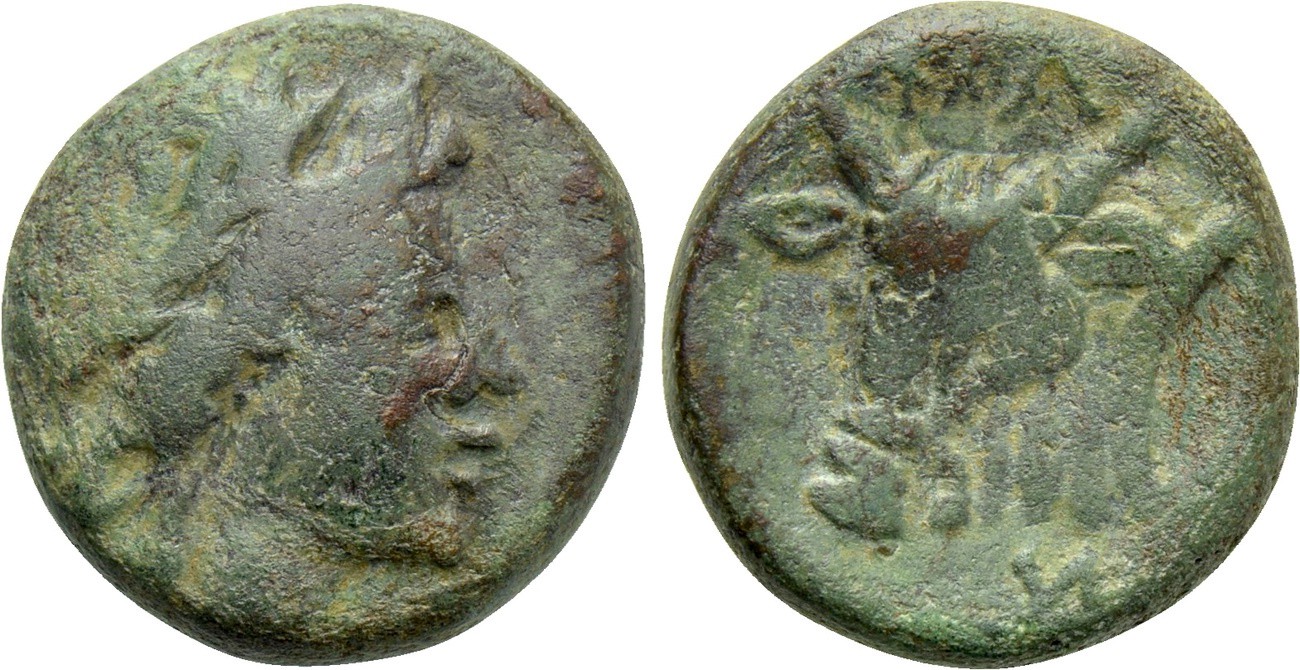H 136 - Athamanes, bronze (Apollo/bull) (220-185 BCE)
From SILVER
220 BCE - 185 BCE Bronze
Description
| ObverseInscription or printing placed on the obverse.: | Laureate head of Apollo right. |
| ReverseInscription or printing placed on the reverse.: | ΑΘΑMΑΝΩΝ (Greek).Head and neck of bull facing slightly left. |
Mint and issuing power
| MintIdentifies the place of manufacture or issue of a numismatic object.: | Athamanes | Ancient regionAncient region.: | Epirus | Modern countryModern country: Greece | AuthorityIdentifies the issuing power. The authority can be "pretended" when the name or the portrait of X is on the coin but he/she was not the issuing power. It can also be "uncertain" when there is no mention of X on the coin but he/she was the issuing power according to the historical sources: |
Chronology
| FromIdentifies the initial date in a range assigned in a numismatic context. | 220 BCE | toIdentifies the final date in a range assigned in a numismatic context.. | 185 BCE | PeriodTime period of the numismatic object.: Hellenistic 323-30 BC |
Physical description
| MetalThe physical material (usually metal) from which an object is made.: | Bronze |
Median weightMedian of the weights of numismatic objects (in grams). in grams | 3.70 | DenominationTerm indicating the value of a numismatic object. Examples: tetradrachm, chalkous, denarius.: | StandardStandard.: |
Image

H136 Athamanes.jpeg [1]
References
| Die study referencePublication of the study: | Franke 19611Franke 1961 | ||
| Coin series referenceReference to coin series study: | Sear I2Sear I, n° 1970, RQEMH3RQEMH, n° 136 | ||
Obverse dies distribution
Reverse dies distribution
no distribution is available
Quantification
| Number of obversesNumber of obverse dies. ᵖ (o) | 10 | Number of singletons (o1)The number of singleton coins. ᵖ | 8 |
| Number of reverse diesNumber of reverse dies. (r) | 12 | Number of coinsNumber of coins. (n) | 14 |
| Coins per obverse dieNumber of coins per obverse die. (n/o) | 1.4 | Coins per reverse dieNumber of coins per reverse die. (n/r) | 1.17 |
| Reverse per obverse ratioRatio of obverse dies divided by reverse dies. (r/o) | 1.2 | Percentage of singletons (o1)number of coins (n) divided by the number of singletons (o1) ᵖ | 80 % |
| Original number of dies (O) (Carter 1983 formula)The estimation of the number of coins according to Carter 1983 ᵖ | 27.86 | Coins struck if 20,000 as average productivity per dieCoins made if the average productivity for obverses (according to Carter) is 20,000. ᵖ | 557,200 |
| Original number of dies (O) (Esty 2011 formula)The estimation of the number of coins according to the singleton formula in Esty 2011 ᵖ (O) | 35 | Survival rate if 20,000 as average productivity per dieSurvival rate if average productivity is 20,000. ᵖ | 0.00003 |
| Coverage (o = % of O) (Esty 1984 formula)Esty 1984 - coverage (% of O) ᵖ (o = % of O) | 42.86% | Die productivity if survival rate 1/2,000Average productivity if survival rate is 1/2,000. ᵖ | 1,005.03 |
| Weight of silver (in kg) if 20,000 coins per die (O = Carter formula)Carter 1983 * Median weight * 20000 (*10 if gold or electrum) ᵖ | n.a. | Die productivity if survival rate 1/5,000Average productivity if survival rate is 1/5,000. ᵖ | 2,512.56 |
Remarks
Most likely one single workstation
References
- ^ Franke, Peter Robert (1961), Die antiken Münzen von Epirus. I : Poleis, Stämme und epirotischer Bund bis 27 v. Chr. Katalog und Untersuchungen, Wiesbaden
- ^ Sear, David R. (1978), Greek coins and their values. Vol. I, Europe, London, xl, 316 p.
- ^ Callataÿ, François de (1997), Recueil quantitatif des émissions monétaires hellénistiques, Numismatique Romaine, Wetteren, X + 341 p.